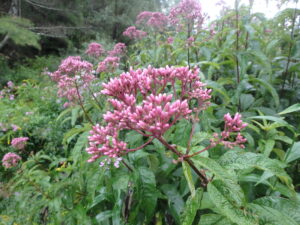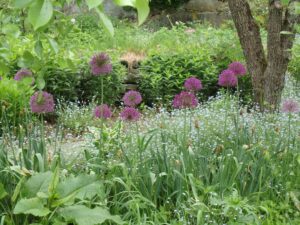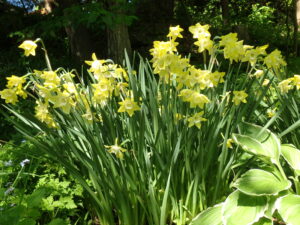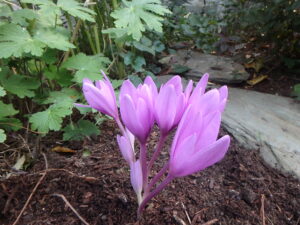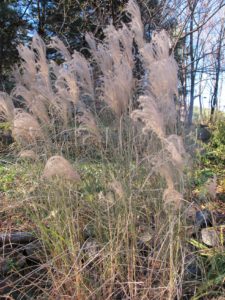Fall Flowers Are Important for Pollinators and Birds
According to Doug Tallamy, the guru of native plants for pollinators, the number one plant we should all have is golden rod – and we probably all do. There are dozens of species of native goldenrod, all popular with bees, moths and butterflies. Many gardeners pull them out when they show up uninvited. A few species spread by root and can take over a flower bed – but others are clump-forming. Even if you don’t want them in your beds, think about leaving them at the edges of your fields or woods.
Joe Pye weed (Eutrochium purpurea) is another tall plant in the aster family. It can get huge – over 6-feet tall if grown in rich, moist soil. A named cultivar called ‘Gateway’ has longer lasting flowers and richer colors than the wild ones, though those are nice, too. Smaller varieties such as Little Joe, Baby Joe and Phantom are nice, and better suited for smaller gardens. I haven’t grown them but see they are sold as being 3- to 4-feet tall. Monarchs and other pollinators love them. All appreciate soil that does not dry out.
I know that many gardeners are already cutting back their flowers in preparation for winter. But hold on! Flowers with lots of seeds can be left as winter snacks for our feathered friends. Among the best are black-eyed Susans, purple coneflower, sunflowers, zinnias, Joe Pye weed, coreopsis, sedums and ornamental grasses. Wait until spring to cut those back so that finches, chickadees, cardinals and other seed-eaters can enjoy them, especially on those cold, snowy mornings when you don’t want to go fill up your feeder.
Planting Bulbs for Spring Blossoms
First the small bulbs bloom: snowdrops, glory of the snow, scilla, winter aconite and crocus. Next come daffodils, tulips and alliums. Finally come summer snowflake ( Leucojum spp.) and Camassia. You have plenty of time to plant bulbs as you can do so until the ground freezes. But I recommend that you get them now before they are sold out. Gardening has taken a big uptick in interest this year, and I predict bulbs will go the way of seeds and hoses – all sold out early.
Planting depth matters. The small bulbs only need 2 or 3 inches of soil cover over the top of the bulb; bigger bulbs like tulips and daffodils generally need 6 inches of cover. Follow the directions that come with the bulbs.
I like to plant bulbs in big batches. Fifty daffodils will knock your socks off when they bloom, but five will hardly be noticed. I know that some stores sell tools that can be used to cut out and lift a circle of soil all in one motion. The idea is to dig lots of holes (3 inches across) and plant one bulb in each hole. I find that method tedious. The same goes for using an auger on a drill to dig holes for bulbs.
What I like is to dig a bulb bed for 25 or more bulbs. Dig down six inches, remove the soil in an oval or circle 24 to 36 inches across. I put the soil in a wheelbarrow or on a tarp so as to keep the area tidy. Once the hole is excavated, I add some bulb booster or slow-release organic fertilizer in the hole with my CobraHead weeder. I generally add some compost, too, and scratch it into the soil at the bottom of the hole, along with the fertilizer.
There are a few fall blooming bulbs, too. Saffron crocus and Colchicum need to be planted before this, but you might like to try them another year. Colchicum, generally planted in August, is also called “fall crocus” (even though it is not a crocus at all). But the blossoms look like giant crocus, and each bulb produces several blossoms. I love them.
Fifteen Flowers That Bloomed in October in My Garden
Despite frost and short days, my garden produced plenty of flowers in October. I look for plants that will perform in the shoulder seasons – March, April, October and even November. Here are some I love that are blooming still, or that bloomed earlier in October.
- My ‘Knockout’ roses were still blooming in late October. This trademarked variety has me completely loyal to them. They start blooming in June, and continue until Halloween or later. Not every bush blooms every day, but some do. Most are not fragrant, though that has its advantage: they don’t attract Japanese beetles or rose chafers.
- Seven Sons Flower tree (Heptacodium micinoides). The small white flowers on this tree are delicate, and slightly fragrant. It’s fast growing, small tree that needs annual pruning – it can grow stems up to 7 feet long in one season, though it shouldn’t get taller than 25 feet or so. Hard frost damages the flowers.
- Witchhazel (Hamamelis virginiana). This understory tree has small curly yellow blossoms that really aren’t obvious until late October when the yellow foliage falls off. The branches of mine are loaded with blossoms now, and will look good well into November. Not a showy plant, but a welcome treat at this time of year.
- Disanthus (Disanthus cercidifolius). This large shrub has spectacular purple foliage, more dramatic than the reds of burning bush (Euonymus alatus). And if you get up close for a look, it has little half-inch red blossoms in October. Quite a worthy shrub, but not well known. Even though I’m in a cold zone 4, and this shrub is said to be only hard to Zone 5 (minus 20), I’ve had it for several years.
- Autumn crocus (Colchicum speciosum). This is my one
bulb plant for October. It is similar to spring crocus, but many times larger. I was given a dozen bulbs 20 years ago, and now I have just one left – the others seem to have disappeared. It displays its foliage in spring which then disappears. In October large pink (or white or lavender) blossoms appear. Floppy, but wonderful. I shall buy some more next summer.
- Fall monkshood (Aconitum carmichaelii ‘Arendsii’). You may know the June-blooming monkshood (Aconitum napellus), but this late bloomer is a treat that blooms in late October. It grows to be 4 to 5 feet tall, and has an intense blue-purple hooded flower. Also called wolf’s bane because the sap was used allegedly used to poison wolves in Russia by spreading it on meat that was left out for wolves.
- Blooming with my monkshood is a pink-magenta phlox. Unlike the other phlox I have, this one starts late and just keeps on blooming. I wish I knew the cultivar name, as it has little mold or mildew, too. A good cut flower.
- Rudbeckia I have 2 varieties that bloom well into October. ‘Henry Eiler’ is just finishing up. A 5-foot tall plant with petals with gaps between them give it a distinctive look. And then there is ‘Prairie Sun’ which blooms from late June until now. It has a green eye, instead of a brown one.
- Globe flower (Trollius europaeus). The bright yellow flowers are a complete surprise, as it should bloom in early summer. But this year it is in full, glorious bloom in the last week of October. Go figure.
- New York ironweed (Vernonia noveboracnesis). This is a tall purple flower that looks a lot like a New England aster. It can reach 5 to 6 feet tall in moist rich soil, which it likes best. I now grow it in dry soil, as it got too big in moist soil. It bloomed well though mid-October for me.
- New England Aster (Aster novae-angliae). Another tall fall bloomer, I have pink and purple varieties that often reach 5 to 6 feet tall. Monarch butterflies love to get some nectar from the flowers before heading south.
- Canadian burnet (Sanguisorba canadensis). A native plant of the wetlands, this tall flower appears as a dozen thin bottle-brush flowers on each stem, in clusters. I have 3 or 4 other species in this genus that bloom earlier in summer.
- Sneezeweed (Helenium autumnale). This flower was named after Helen of Troy, a woman so beautiful that it said she launched 1,000 ships. I have it in various colors: yellow, yellow and rust, orange and brown. It can be 5 feet tall, or as short as 2 feet, depending on where it is grown and the cultivar. It does fine in ordinary garden soil, but thrives best in moist soils. Sneezeweed does not make you sneeze – it was used as snuff in earlier times.
- Pink Turtlehead (Chelone lyonii). This tall pink flower blooms for 6 to 8 weeks with multiple hooded pink flowers on tall stems. Bumblebees love this flower, though it is a challenge for them to crawl inside for pollen. It finished blooming in mid-to-late-October.
- Fountain grass (Miscanthus sinensis ‘Morning Light’).
Most of us do not think of grasses as having flowers, but they do, of course. This 6- to 8-foot tall grass has wonderful fluffy panicles a foot long or so. They move well in the breeze, and many stay erect through much of the winter.




